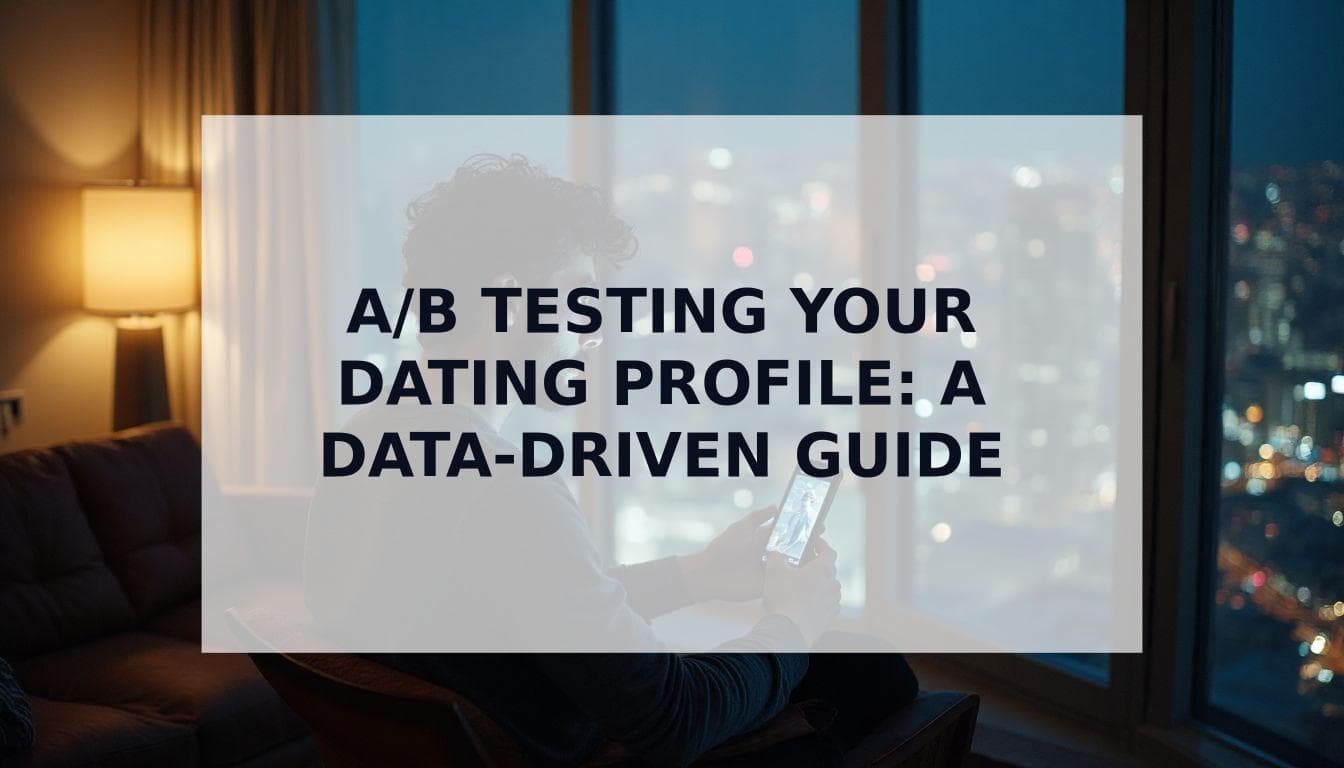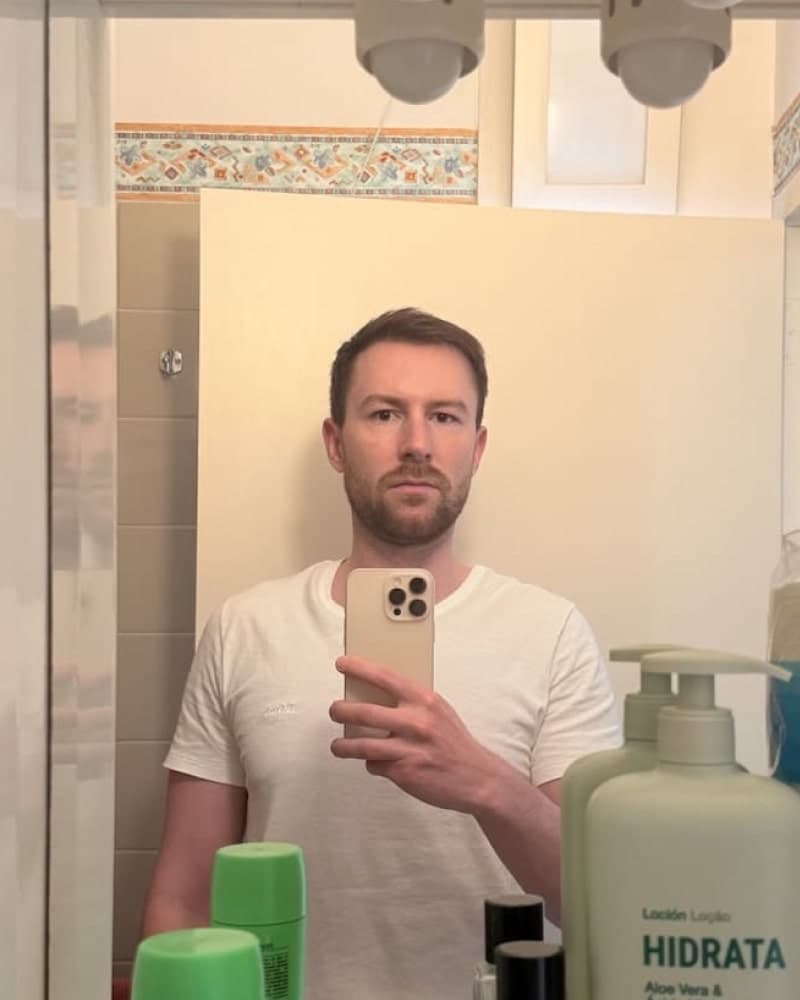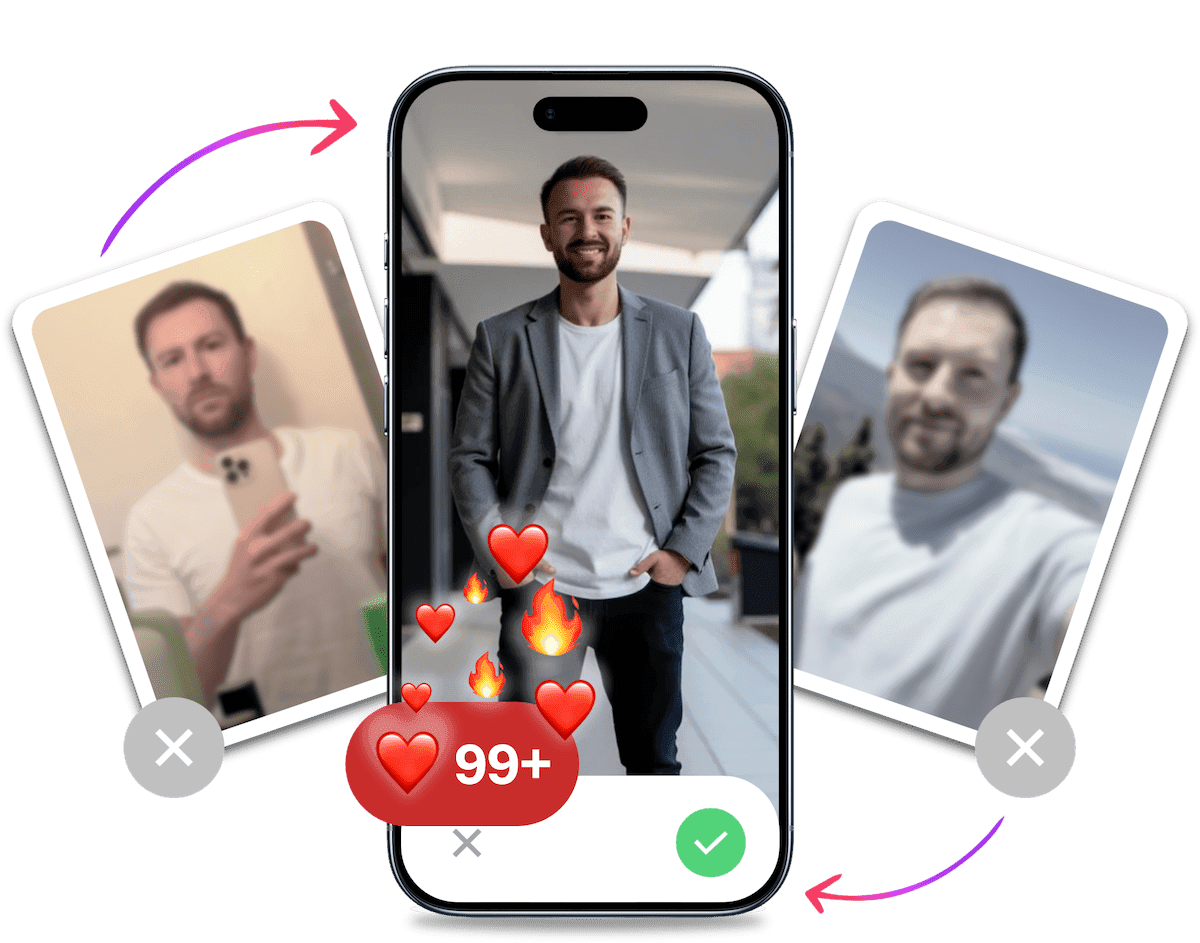
A/B Testing Your Dating Profile: The Data-Driven Guide to Getting More Matches
Are you spending hours swiping on dating apps, only to be met with a frustrating lack of results? If you feel like you're shouting into the void, you're not alone. Many guys feel like they're doing something wrong but can't figure out what it is.
The solution isn't to swipe more. It's to swipe smarter. We're going to show you how by A/B testing your dating profile. It’s a method for comparing two versions of something to see which one performs better, and it's the secret weapon used by giants like Netflix and Amazon to keep you hooked.
This guide provides a step-by-step framework to stop guessing. You'll learn how to use data to systematically improve your match rate on apps like Tinder, Hinge, and Bumble.
And the single biggest lever you can pull? Your photos. We'll show you exactly how to test them for maximum impact.
What is A/B Testing and Why Does It Work for Dating Apps?
Let's break down A/B testing, also known as split testing. It sounds technical, but the concept is simple.
Imagine you're marketing a new movie. You create two different posters. You show Poster A to one group and Poster B to another. Whichever poster convinces more people to buy a ticket is the winner. You're doing the exact same thing, but the product is you, and the "ticket" is a right swipe.
This approach gives you a massive advantage in the world of online dating, where small changes can lead to huge differences in your results.
The Problem with the "Set It and Forget It" Profile
Here's what most guys do: they upload a few random photos from their camera roll, scribble a quick bio, and then hope for the best. They might tweak a word here or there, but the profile essentially becomes static. A digital fossil.
When the matches don't roll in, they get frustrated and blame the app or assume something is wrong with them. The real problem is the approach. Without testing, you have no idea what's actually working or, more importantly, what isn't. You're flying blind when you could be using a GPS.
The Scientific Advantage: Isolate, Test, Iterate
The core principle of A/B testing is beautifully simple: change only one variable at a time. This is critical. If you change your main photo AND your bio simultaneously, you won't know which change caused the increase (or decrease) in matches.
By isolating a single variable—your first photo, your second photo, a specific Hinge prompt—you can know with certainty what caused the change.
Your key metric for success is simple: the number of new likes or matches received over a set period. A 7-day window is usually a great starting point. This gives you a clear, data-backed winner for every test you run. It's one of the best dating profile tips you'll ever get.
The Ultimate A/B Test: How to A/B Test Your Dating Profile Photos
Let's get straight to the point. Research suggests that your dating app photos are responsible for up to 90% of a person's decision to swipe right.
That is an absolutely massive number.
This means that your pictures are the highest-impact variable you can possibly test. Optimizing your photos isn't just a good idea; it's the entire game. If you want to improve your dating profile, this is where you must start.
The A/B Photo Testing Bottleneck: Why Most Men Can't Do It Right
So, if testing photos is so important, why doesn't everyone do it? Because of a major bottleneck: you need a supply of good test subjects.
To run a proper A/B test on your pictures, you need multiple, high-quality photos that are stylistically different from one another. This is where most guys hit a wall. Let's look at the old, broken solutions.
- Using your existing photos: Your camera roll is probably a graveyard of similar-looking selfies, blurry group shots, or photos that are five years out of date. You simply don't have enough diverse, quality options to run a meaningful test.
- Hiring a photographer: A professional dating photoshoot can cost $500 or more. Worse, the photos often look incredibly staged, try-hard, and inauthentic. It's not a practical way to generate a dozen different styles to see what truly resonates.
You can't test what you don't have. Testing two bad photos against each other only tells you which one is slightly less bad. That's not a winning strategy.
The Solution: Generating Your Photo "Testing Portfolio" with AI
This is where everything changes. Instead of struggling to find usable photos, what if you could generate an entire portfolio of testable, high-quality images in minutes?
That's exactly what we built at TinderProfile.ai.
Instead of one expensive photoshoot, our AI generates 100+ photos in dozens of different styles, giving you a complete portfolio of high-quality 'test subjects.' You get candid shots, professional shots, adventurous shots, and more. All with your face, all hyper-realistic.
We're not a generic headshot tool for LinkedIn. Our AI is built exclusively for dating. It understands what creates attraction and authenticity on apps like Tinder and Hinge. We deliver realistic AI dating photos that look like they were taken by a friend on a great day. It's you, just at your absolute best.
You get a massive arsenal of A/B testing ammunition without the awkwardness or expense of a photoshoot.
Generate Your Photo Test Portfolio Now
Step-by-Step Guide: How to Run an A/B Test on Your Tinder/Hinge Photos
Ready to become a dating scientist? Here is the exact, step-by-step process for A/B testing your dating profile pictures. Follow this, and you will get more matches.
- Establish Your Baseline (The "Control"). Before making any changes, you need to know your starting point. Run your current profile exactly as it is for one full week (7 days). At the end of the week, record the total number of new likes or matches you received. This number is your baseline.
- Formulate Your Hypothesis. A hypothesis is just an educated guess. For example: "I believe a photo of me smiling candidly outdoors will get more matches than my current serious, indoor headshot." This defines what you're testing.
- Create Your "Challenger" Profile. Now, it's time to build your test. Keep everything else on your profile exactly the same—your bio, your prompts, your other photos. The only thing you will change is the single variable from your hypothesis. Swap your "control" first photo with your new "challenger" photo (e.g., one of the awesome new ones from your TinderProfile.ai portfolio).
- Run the Test. Let this new "challenger" profile run for the same amount of time as your baseline test—another 7 days. This ensures you're comparing apples to apples, accounting for weekday vs. weekend activity spikes.
- Analyze the Results. At the end of week two, compare the numbers. Did your baseline profile get 15 matches while your challenger profile got 25? If so, you have a clear winner! Your hypothesis was correct. The challenger photo now becomes your new "control" main picture.
- Repeat and Iterate. The process doesn't stop here. Optimization is a continuous loop. Now, you can test your new winning photo against another style. Or, you can keep your winning first photo and test your second photo. The key is to keep iterating, making small, data-driven improvements over time to constantly optimize your Tinder profile.
Beyond Pictures: How to A/B Test Your Bio, Prompts, and More
While photos are the undisputed champion of dating profile optimization, the words you use still matter. They can be the difference between someone being intrigued enough to send a message or swiping left after liking your photo. Applying the A/B testing method here can give you another powerful edge.
This section proves you're not just relying on looks. You're building a comprehensively attractive profile.
Testing Your Bio: Short & Punchy vs. Detailed & Descriptive
Your bio is your elevator pitch. But which pitch works best? A short, witty one-liner or a more descriptive paragraph that reveals more about your personality? Let's test it.
Keep your photos constant for this test. Run each bio for a week and see which one gets more matches.
| Test A (Control): Short & Punchy | Test B (Challenger): Detailed & Descriptive |
|---|---|
| "Software engineer. Love hiking and trying new breweries. My dog is cooler than I am." | "I build cool things with code during the day and explore the mountains on weekends. Currently on a mission to find the best IPA in the state. Recommendations welcome. Looking for someone who doesn't take themselves too seriously." |
Test A is direct and easy to scan. Test B is more engaging and includes a call-to-action ("recommendations welcome"), which can prompt more conversations. Only testing will tell you what works for your audience. For more ideas, check out some of the best Tinder bios for guys we've analyzed.
Testing Hinge Prompts: Funny & Witty vs. Serious & Sincere
Hinge is all about prompts. They are your primary way to showcase your personality. But should you go for the laugh or the heartstring? Let's test it on a prompt like "I'm looking for..."
- Test A (Funny): "...someone to help me reach the top shelf at the grocery store."
- Test B (Sincere): "...a genuine connection with someone who is passionate about their own hobbies and interests."
Again, isolate this one variable. Change only this one prompt response, run it for a week, and track your matches. You might find that a mix of funny and sincere prompts works best, and you can discover that perfect mix by testing each prompt one by one. If you're stuck, exploring some of the best Hinge prompts can provide great inspiration for your tests.
No Likes? No Replies?
It's Probably Your Photos.


Average users see 8x more right swipes with our AI photos. Stop wasting time on dating apps and join 50,000+ singles who have already found better dates with TinderProfile.ai.
What Other Variables Can You Test?
Once you get the hang of it, you'll see testing opportunities everywhere. Here are a few more ideas to get you started:
- The order of your photos (after you've locked in your best first photo)
- Including a group photo vs. having only solo shots
- Your job title or anthem on Tinder
- The primary "interest tags" you display
- Your "About Me" stats on Hinge (e.g., political views, drinking habits)
Common A/B Testing Mistakes to Avoid
A data-driven approach is powerful, but only if you do it correctly. Many well-intentioned guys sabotage their own tests by making simple errors. Here are the most common dating profile mistakes to avoid.
- Testing Too Many Variables at Once. This is the cardinal sin of A/B testing. If you change your main photo, your bio, and three prompts all at once, your data is meaningless. You have no idea what caused the result. Rule #1: One change at a time.
- Not Giving the Test Enough Time. Getting impatient after a few hours and calling the test is a huge mistake. Dating app activity fluctuates. You need at least 5-7 days for each version to collect a reliable sample size and smooth out any daily anomalies.
- Ignoring App-Specific Features. Be aware of built-in tools. Tinder's "Smart Photos" feature, for example, is a very basic A/B test that automatically finds the best first photo for you. However, it's a black box. It doesn't tell you why one photo works, and it doesn't help you test other photos, styles, your bio, or anything else. For true optimization, you need to do it manually.
- Using Low-Quality "Challengers." Your test is only as good as the options you're testing. If you test two blurry, low-effort photos against each other, you'll just learn which one is less terrible. To get a real lift in matches, you need to test your current best against a truly high-quality challenger. This is why having a deep portfolio of best Tinder pictures from a service like TinderProfile.ai is a game-changer.
Conclusion: Stop Guessing, Start Optimizing
Your dating life shouldn't feel like playing the lottery. It doesn't have to be a game of chance where you just cross your fingers and hope for the best.
By applying a simple, data-driven A/B testing framework, you take control back. You transform from a passive participant into an active optimizer of your own success. You stop guessing and start knowing what actually works.
Remember, the single most important element you can possibly test is your photos. They are the gateway to every like, every match, and every conversation.
But you can't A/B test what you don't have. Don't let a lack of good photos hold you back from getting the results you deserve.
Get your ultimate testing portfolio today.
Create My AI-Powered Photos and Start Testing
FAQ: Your A/B Testing Dating Profile Questions Answered
Here are some quick answers to the most common questions about A/B testing your dating profile.
How do you A/B test a dating profile?
It's a simple, scientific process. First, you establish a baseline by running your current profile for a week and recording the number of matches. Then, you change only one variable—like your main photo or your bio. You run this new version for another week and compare the number of matches to your baseline to find the winner.
How can I A/B test my Tinder photos?
The best method for an A/B test on Tinder profile pictures is to manually swap them while keeping your bio and other elements the same. The biggest challenge is having enough varied pictures to test. For a truly effective test, you need a diverse set of high-quality photos in different styles, which is why AI photo generators like TinderProfile.ai are so powerful for this specific task.
Does A/B testing actually work for dating profiles?
Yes, absolutely. A/B testing works because it replaces guesswork and assumptions with a data-driven approach. Instead of wondering what people like, you can systematically test different elements to find out what resonates most with your target audience. This leads to better dating app profile optimization and a higher match rate over time.
What metrics should I track?
The primary metric you should always track is the number of new matches or likes you receive over a set period (like 7 days). This is the clearest indicator of your profile's top-of-funnel appeal. Secondary metrics could include the number of conversations started or replies received, which can help you test things like your bio's conversation-starting potential.
